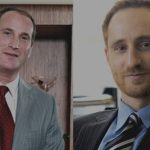Category Archives: In The News

The Believer: An interview with Matthew Blesso
An interview with Matthew Blesso (article source click here)
Matthew Blesso, founder and CEO of Blesso Properties, designs buildings to fulfill the physical and psychological needs of those who live in them. As a sustainable real estate developer, Blesso’s properties conserve water and continuously strive to reduce their carbon footprint. His process emphasizes passive strategies, an approach that harnesses the energy of the surrounding environs through building placement (relation to the sun), minimizing of technology, using materials that have a high thermal mass, and inclusion of plant life, particularly green roofs.
I met Blesso while heading a photography project on advanced uses of urban ecology in New York City. The green roof (designed by Balmori Associates, pictured above) atop his NoHo apartment is undeniably among the best in the city: a verdant, multi-tiered garden that benefits his life practically and pleasurably. The foliage absorbs rain water, prevents flooding sewers, cools the building in the summer, warms it in the winter, produces oxygen and reduces pollutant gases such as nitrogen, carbon monoxide, sulfur dioxide and ground level ozone. Blesso’s green roof demonstrates how sustainability can be achieved through smart design, a mindset embedded in his building practice.
On two separate occasions Matt and I spoke on the phone about his projects, the financial incentives for building sustainably and how to push the green movement forward. – Katie Bachner
THE BELIEVER: Green real estate development integrates social and environmental goals with financial considerations. What are some of the challenges to building green that you have experienced?
MATTHEW BLESSO: I think first and foremost it’s getting other people to embrace it and unfortunately, that even includes design professionals. Green building is often more work and more money. So if you already have a budget and the design professional has to meet this budget they actually have to put in a lot more time on some things that are going to raise the costs and make your job that much harder – it is often harder to enlist them. Then you will have other cases where you will have professionals that simply haven’t done sustainable things before – whether it’s engineers or sub contractors – so it’s ultimately only the developer that can push the process. That’s one challenge, the second one is the lack of a cohesive standard. LEED [Leadership in Energy and Environmental Design] has been the default standard and even that doesn’t have the respect that it did when it started. The third thing I would say is the lack of impetus by our political leaders to really embrace sustainable regulations. I think it’s better at the local level than it is at the national level. New York City is definitely more forward thinking in this regard than a lot of other cities and that really started with Bloomberg, but in my mind there shouldn’t be a choice as to whether to develop a green building. Everyone should have to incorporate sustainable practices, it shouldn’t be this option and we are really a long way from that.
BLVR: Right now sustainable development really depends on the private sector. Companies and developers really have to take that initiative.
MB: Well that’s the way it is today but what I am suggesting is that it doesn’t have to be that way. There can be regulations put into place, and I know the real estate board of New York and the industry are against these regulations but I am all for it. It doesn’t have to be a private choice; there could actually be far greater standards about the way we do things. LEED could be used as an example. LEED is very imperfect but it could just be a requirement for all buildings that everything has to be LEED certified, not that you get extra points for it, but because it’s the way you have to do it. Even if it makes economic sense, a lot of people just don’t know how to build sustainably and I think that when you are in a crisis you have to force people to learn. When architects are studying in school they shouldn’t have the option of taking sustainability it should just be the way building is done. You know that’s just the mindset, optionality just really needs to come out of it.
BLVR:I think there is this misunderstanding that transitioning into a green market place will lose jobs, while in reality doing so would create so many more jobs. Industries ranging from Lighting to HVAC systems to windows and materials across the board would need to change and be re-distributed. This would also prove in the long run less expensive for the consumers who use them.
MB: The increased costs in many cases are just kind of temporary because the more people who use sustainable products the more the cost of them comes down. Building things sustainably in general has become a lot cheaper in the last few years just because there is a lot more technology out there than there was before. We are producing more of it. Also the more that people learn how to do it the more it becomes part of the market place. When you factor in energy savings I don’t know if it even is more expensive.
BLVR: I think one of the best ways to make green building catch on is to make it as experientially interesting as possible. With all your buildings, it seems like design really plays a pivotal role.
MB: Oh yeah. We start with design, it’s not an after thought. It envelops everything we do and affects every decision that we make. We want all of our projects to stand out on their own and be special places. That’s irrespective of whether or not they are high end or more moderate income.
BLVR: What are some of your favorite technologies that you would like to use in buildings now or down the line?
MB: I think to answer your question a little differently, I think that in many cases I would like to use a lack of technology. I would like to use as little mechanical heating and cooling as possible and focus on passive heating and cooling. You know that’s not something that people have thought about much until the last couple of years. But you know the orientation of the house located relative to the sun for instance and wind can have a huge impact on how a house is heated and cooled. What you make it out of as well. The best thing you can do is not have a need for technology.
BLVR: Do you think energy management systems that help keep tabs on the amount of energy a building is using is something that should be incorporated into new buildings?
MB: Definitely. People don’t realize what they use and another thing that we like to do is just put it in the hands of the tenants. In most buildings in New York they just provide heat all the time and some buildings, depending on what they are used for, may provide AC. In many of the areas the lights are on 24/7. So we try to look at all of those things. We just did a project in Chelsea where we actually put in individual heat and air conditioning units so that tenants have to pay for it themselves. We have to pay more to install individual systems like that- but because tenants are getting the bill they will presumably turn their heat down or off when they are going out for the day. That saves a great deal of energy. The system that monitors a building’s energy use is a new technology but I think it’s the future. It will certainly allow for a lot of significant improvement in energy consumption.
BLVR: In addition to energy, conserving water is becoming increasingly important. What types of passive strategies are there to deal with water conservation?
MB: Green roof systems. You know what I was saying before about requirements, it should just be a requirement that every new building needs to have a green roof. You know because we just spit all that water out and it mixes with the waste water. When we have a big storm we are producing more water than the treatment facilities can actually handle and that means sewerage water is entering our waterways but if it were all just absorbed by roofs that wouldn’t happen.
Water is just going to be a bigger and bigger problem. It is going to be just like the oil problem in the next 50 or 100 years. It’s a shrinking commodity. We are just using more than we are replacing in terms of potable water. We have to do something differently. The reclamation and treatment is certainly a part of that.
BLVR: Where do you go to get expertise on sustainable materials, whether it be local or certified in a particular way or recycled ?
MB: This one is a little tougher because there is no one great answer – like this is the best material to use. You use the best information you have and then you make decisions. For instance bamboo is generally cited as a good material to use. I have it in my office and use it in other projects but it also comes from China so a lot of carbon is produced in shipping it to the U.S. It also has a lot of glues which have a varying degree of toxicity in them. So you think you are doing a good thing – I am not saying you shouldn’t use bamboo, but these are complicated answers. FSC [Forest Stewardship Council] certified wood comes from the west coast so if you want that stamp on your wood chances are you gotta get it from the west coast. So it’s FSC certified but you have to ship it across the country, which isn’t so great. It’s like when you’re buying food, is it better to get organic food or local food? There is not really a right answer to this.
BLVR: In terms of guiding systems, are there any other guiding systems that you find more helpful than LEED?
MB: No, I think LEED is the best we’ve got and I think it will get better. It was a good starting point. We had to start somewhere and do something and so I think everyone including those who administer recognize that it’s imperfect and that it will improve over time.

The New York Observer: The Heat Seeker
The Heat Seeker: Blesso Properties’ Albert Price on the Next Big Nabe (article source click here)
How does a small-town boy from Duxbury, Mass., predict what the next big neighborhood in New York will be? Albert Price, the newly named president and chief operating officer of Blesso Properties, has spent his 20-year career developing commercial, residential and multifamily properties in areas that he believes will be deemed the Big Apple’s next hot spot. The Commercial Observer spoke to Mr. Price, about the challenges of starting a new development and his excitement about a hotel project in Panama.
The Commercial Observer: How difficult is it to kick-start a development—not just any development, but the right one—in New York City today?
Mr. Price: I think with any development project, there are sort of two kinds of developers in terms of how Matt [Blesso, Blesso Properties founder and president] and I see it: You have your commodity developers that basically develop into a demand in the marketplace, and they are looking at bigger macroeconomic data and saying, ‘O.K., we think that over the next X number of years there’s going to be this much demand for this type of product, so let’s go out and figure out where the right places to build it are.’ Or they buy existing buildings and convert them into different uses, or even just buy existing buildings that they think because of the demand behind it that that product is going to experience more upside than others.
Matt and I have a somewhat different approach, and I think with most boutique real estate development companies they, to some degree, have the same approach. We really start with a concept, we start with a vision, of a niche in the marketplace where we see some sort of a demand. With respect to the [421 West] 22nd Street project, the niche that Matt saw there was really the niche of really not being able to purchase studio apartments that were improved to a level of finish and design that a typical high-end buyer would like. Most of the studios that are available in Manhattan are rentals. They’re not for sale. I think the 22nd Street project was really geared toward a reinvention of the studio into something that could be created as a condo and purchased by a buyer as a condo. We had a concept for design, sort of what are the things that studios in general—apartments in New York City—don’t have. Particularly with respect to studios, they don’t have a lot of storage and they also typically don’t have nice kitchens, and you’re typically challenged with space, because you have to fit furniture—a bed, a desk, workspace, an office, a dining room table—you have to fit that into one small room.







